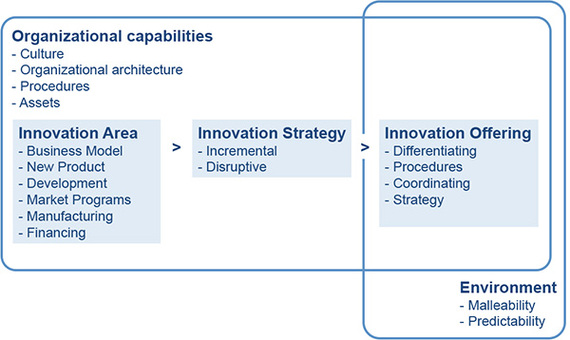Corporations and governments proclaim that design and innovation, are the twin engines for future progress, especially within the Creative Economy. Nothing new here, - since innovation has fueled the explosive development of the last two hundred years. However, most are still unclear on exactly what innovation entails. What constitutes an (1) innovation area, (2) innovation strategy or an (3) innovative product, service or experience offering and which combination is right for an organization's given situation?
Innovation is Purposeful Change
The lifeblood of any organization is matching its unique internal capabilities (Enablers: technology) with external needs (Drivers: market), to attract resources, which then enables growth. In the competition and collaboration between organizations in ecosystems, those most adaptable to change, survive and even thrive. In a dynamic environment, an organization's ability to change is largely dependent on its ability to successfully innovate.
(1) Innovation Area
Depending on the organization's environment, the organization can decide to innovate in a range of areas. The key factors for an organization's environmental strategy include malleability (effecting how much the organization can influence its surroundings) and predictability (effecting how reliable planning can be done.) The innovations might include, but not be limited to: Business Model, New Product Development, Market Programs (Price, Promotion, Place, Delivery), Manufacturing and Financing. In addition, innovation can entail effective integration between these areas.
(2) Innovation Strategy
For each of these areas, organizations can select strategies ranging between two extremes, a Sustainable Strategy (optimizing business as usual) to a Disruptive Strategy (changing the way business is done). Sustainable Strategies are managed though investment approaches and are associated with low return and low risk, while Disruptive Strategies are managed though betting approaches, with each bet having potentially high return and also high risk associated with it.
(3) Innovative Offerings
For New Product Development, designers can contribute at four levels, adding increasingly higher values. At the lowest level - design differentiates offerings (function, styling, ergonomics.) At the second level, design assists streamlining the procedures (research, conceptualization, prototyping, detailing, refining.) The third level, design assists in creating unique internal and external configurations of activities (by managing people and resources). Finally, at the top-level, design assists in creating actionable strategies. Each of these four steps (differentiating, procedures, coordinating and strategy) represents opportunities that stretch from incremental to breakthrough innovations.
Matching Organization with Environment
The strategy selected by an organization depends on its culture (values, beliefs and attitude), organizational architecture (how people relate and report to each other), internal procedures (guidelines and practices for how things get done) and available assets (cash, real-estate, equipment, goods, etc.). Strategies rooted in upper level capabilities, such as culture, are extremely difficult for competitors to imitate and therefore represent a significant competitive advantage. Strategies relying on simply moving assets around, on the other hand, are easy to replicate and therefore impossible to defend.
So, where does design come into play? Design matches external opportunities to internal capabilities, such as market needs with technology solutions. Design does not necessarily have to be carried out by management, industrial designers or engineers; anyone can be designing, in isolation or as part of a design team.
Innovation and Risk
Conducting incremental innovation represents about ninety percent of all innovations and is, in many ways, teachable. Opportunities are perceived as known and solutions to challenges can be extrapolated from existing knowledge and then tested. The external factors' effect is predictable so risk can therefore be managed and the financial ramifications can be estimated. Incremental innovation is best done by cross-functional collaborating teams following a prescribed procedure, which then result in more meaningful offerings. However the approach has a negative effect on novelty.
Breakthrough innovation, where opportunities are unknown or poorly understood, challenges and solutions elusive, risk high and returns unclear, is a completely different animal. Because breakthrough innovation is rare (about ten percent), few have any experience in managing the process. Often breakthrough innovations take a certain type of individual and organizational culture, both of which are mostly found in startups. Though breakthrough innovation is more of an art than a science, multiple approaches exist for managing it. These include the "Dark Horse Approach," "Gamification," "Lean Startup" and "Customer Discovery."
The ability to create breakthrough innovation requires deep knowledge of multiple domains. Therefore, a designer's ability to contribute to innovation depends not only on design expertise but also on their ability to understand and bridge distant user and technical domains. These domains might include the needs of retired people, age related ergonomics along with rapid prototyping and interface knowledge. Updating the look of a product is easy; however making the world a better place involves deep knowledge, hard work and experience.
